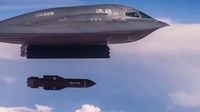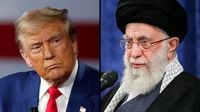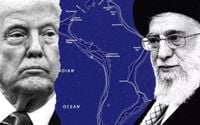In a dramatic escalation of tensions in the Middle East, President Donald Trump has issued a stark warning to Iran, threatening unprecedented bombings if the country fails to negotiate a new nuclear deal with the United States. This ultimatum was delivered during an interview with NBC News aired on March 30, 2025, where Trump underscored the potential consequences for Tehran if it does not comply within a two-month deadline.
The threat comes as the U.S. military has recently deployed B-2 Spirit stealth bombers to Diego Garcia, a remote U.S. base in the Indian Ocean, approximately 3,300 miles from Tehran. Satellite imagery from Planet Labs, reported by The Times of Israel on March 29, confirmed that at least four B-2 bombers have arrived at the base, heightening speculation about a possible military strike on Iran’s nuclear facilities.
Trump's warning follows a letter sent to Iran’s Supreme Leader Ayatollah Ali Khamenei, mediated through Oman, demanding a new agreement to curb Tehran’s nuclear program. Iran’s Foreign Minister Abbas Araqchi acknowledged receipt of the letter but rejected direct talks, leaving open the possibility for indirect negotiations, as reported by NPR.
At the center of this standoff is the B-2 Spirit, a stealth bomber designed to penetrate heavily defended airspace and deliver massive payloads. The B-2, manufactured by Northrop Grumman and entering service in 1997, boasts a wingspan of 172 feet and is powered by four General Electric F118 engines capable of producing 17,300 pounds of thrust each. It achieves a top speed of 628 miles per hour and has a range of 6,900 miles, extendable to over 11,000 miles with aerial refueling, and can carry a payload of up to 40,000 pounds, including the GBU-57 Massive Ordnance Penetrator—a 30,000-pound bomb designed to destroy deeply buried targets.
Only 20 B-2s are operational in the U.S. fleet, each valued at $2 billion, making them a rare and potent tool for targeting fortified sites like Iran’s Natanz and Fordow nuclear complexes. The B-2’s capabilities position it as a centerpiece of Trump’s threat, offering precision and power unmatched by cruise missiles or drones.
Iran's nuclear ambitions have long been a flashpoint in U.S.-Iran relations. Following the Trump administration's withdrawal from the 2015 Joint Comprehensive Plan of Action (JCPOA) in 2018, a “maximum pressure” campaign was initiated, imposing sanctions that crippled Tehran’s economy. In response, Iran accelerated its uranium enrichment, reaching 60 percent purity by late 2024, dangerously close to the weapons-grade threshold of 90 percent, according to the International Atomic Energy Agency.
The logistics of a potential U.S. strike from Diego Garcia would be complex. A round trip to Tehran exceeds 6,600 miles, necessitating midair refueling from KC-135 or KC-46 tankers. Moreover, the operation would require suppression of Iran’s air defenses, likely involving F-22 Raptors or electronic warfare aircraft such as the EA-18G Growler. Iran’s Revolutionary Guard Corps maintains an arsenal of ballistic missiles, including the Fateh-110 and Shahab-3, which could reach U.S. bases in the region in retaliation.
The geopolitical stakes are high. The Strait of Hormuz, through which 20 percent of the world’s oil passes, could become a flashpoint if Iran mines the waters or deploys fast-attack boats, tactics rehearsed since the 1980s Tanker War. A 2019 report from the Center for Strategic and International Studies estimated that a conflict could spike oil prices to $150 per barrel.
Beyond Iran, the U.S. military posture is reverberating across the Middle East. The deployment of B-2s coincides with intensified Houthi attacks on shipping in the Red Sea, supported by Iranian-supplied drones and missiles. Fox News reported on March 28 that the bombers serve as a warning to both Tehran and its proxies, a message reinforced by recent U.S. Navy strikes on Houthi targets in Yemen.
Israel, a vocal advocate for preemptive action against Iran, has welcomed Trump’s stance. Prime Minister Benjamin Netanyahu has signaled readiness to coordinate efforts, while Saudi Arabia and the UAE navigate a delicate balance, fearing Iranian reprisals but supporting efforts to curb Tehran’s influence.
Historically, U.S.-Iran tensions have teetered on the brink of conflict. The 1988 downing of Iran Air Flight 655 by the USS Vincennes killed 290 civilians, deepening mistrust that persists today. The 2020 assassination of Qassem Soleimani, ordered by Trump, marked a peak in hostilities, followed by Iran’s missile strikes on U.S. bases in Iraq. The current standoff echoes that era, but with higher stakes as Iran’s nuclear progress has advanced.
In a related development, Iranian officials have issued a stark warning that they will target the UK-US military base on Diego Garcia if the United States proceeds with military action against Iran. A senior Iranian military official stated that Iran would not distinguish between British and American forces if retaliating against any U.S.-led attack. Tehran has vowed to strike the Diego Garcia base, a key U.S.-UK naval installation, should the U.S. launch military operations.
Iran’s state-run media have highlighted the potential use of advanced ballistic missiles, such as the Khorramshahr, and suicide drones like the Shahed-136B, which could strike Diego Garcia from Iranian soil. Approximately 4,000 personnel, including British and American military members, are stationed at Diego Garcia, underscoring its strategic significance.
As the situation unfolds, the U.S. Congress has shown split reactions to Trump’s military posture. Some Republicans laud Trump’s firmness, while Democrats warn of war fatigue, as reported by Politico. Public sentiment in the U.S., shaped by decades of Middle East conflicts, may temper any rush to action, yet the administration’s intent is clear: Iran must bend, or face dire consequences.
The stakes extend to global markets and security. A strike on Iran’s oil infrastructure could disrupt 5 percent of global supply, reminiscent of the 1979 crisis that saw gas lines stretch across America. The Pentagon has bolstered regional assets, with the USS Abraham Lincoln carrier group in the Persian Gulf and F-35s in Jordan.
Trump’s threat and the B-2’s deployment weave a narrative of power and peril. The bomber’s silent menace, hovering over the Indian Ocean, transforms words into tangible intent, challenging Iran to recalibrate or risk ruin. As observers, we see this as a high-stakes gamble—capable of forcing Tehran’s hand or igniting a firestorm that engulfs the region. The administration’s blend of diplomacy and muscle offers a fleeting chance for peace, but history suggests such standoffs rarely end quietly.






